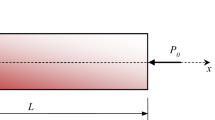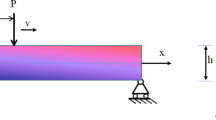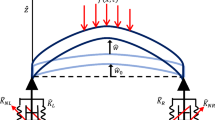Abstract
The analysis of large amplitude vibrations of cracked plates is considered in this study. The problem is addressed via a Ritz approach based on the first-order shear deformation theory and von Kármán’s geometric nonlinearity assumptions. The trial functions are built as series of regular orthogonal polynomial products supplemented with special functions able to represent the crack behaviour (which motivates why the method is dubbed as eXtended Ritz); boundary functions are used to guarantee the fulfillment of the kinematic boundary conditions along the plate edges. Convergence and accuracy are assessed to validate the approach and show its efficiency and potential. Original results are then presented, which illustrate the influence of cracks on the stiffening effect of large amplitude vibrations. These results can also serve as benchmark for future solutions of the problem.







Similar content being viewed by others

References
Amabili, M.: Nonlinear Vibrations and Stability of Shells and Plates. Cambridge University Press, Cambridge (2008)
Bachene, M., Tiberkak, R., Rechak, S.: Vibration analysis of cracked plates using the extended finite element method. Arch. Appl. Mech. 79(3), 249–262 (2009)
Bose, T., Mohanty, A.: Vibration analysis of a rectangular thin isotropic plate with a part-through surface crack of arbitrary orientation and position. J. Sound Vib. 332(26), 7123–7141 (2013)
Bose, T., Mohanty, A.: Large amplitude axisymmetric vibration of a circular plate having a circumferential crack. Int. J. Mech. Sci. 124–125, 194–202 (2017)
Chu, H., Hermann, G.: Influence of large amplitude on free flexural vibrations of rectangular elastic plates. J. Appl. Mech. 23, 532–540 (1956)
Ganapathi, M., Varadan, T., Sarma, B.: Nonlinear flexural vibrations of laminated orthotropic plates. Comput. Struct. 39(6), 685–688 (1991)
Guan-Liang, Q., Song-Nian, G., Jie-Sheng, J.: A finite element model of cracked plates and application to vibration problems. Comput. Struct. 39(5), 483–487 (1991)
Han, W., Petyt, M.: Geometrically nonlinear vibration analysis of thin, rectangular plates using the hierarchical finite element method—ii: 1st mode of laminated plates and higher modes of isotropic and laminated plates. Comput. Struct. 63(2), 309–318 (1997)
Huang, C., Leissa, A., Chan, C.: Vibrations of rectangular plates with internal cracks or slits. Int. J. Mech. Sci. 53(6), 436–445 (2011)
Huang, C., Leissa, A., Li, R.: Accurate vibration analysis of thick, cracked rectangular plates. J. Sound Vib. 330(9), 2079–2093 (2011)
Huang, C., Lin, Y.: Fourier series solutions for vibrations of a rectangular plate with a straight through crack. Appl. Math. Model. 40(23), 10389–10403 (2016)
Huang, C.S., Lee, M.C., Chang, M.J.: Vibration and buckling analysis of internally cracked square plates by the MLS-Ritz approach. Int. J. Struct. Stab. Dyn. 18(09), 1850105 (2018)
Ismail, R., Cartmell, M.: An investigation into the vibration analysis of a plate with a surface crack of variable angular orientation. J. Sound Vib. 331(12), 2929–2948 (2012)
Krawczuk, M.: Natural vibrations of rectangular plates with a through crack. Arch. Appl. Mech. 63(7), 491–504 (1993)
Lei, Z., Zhang, L., Liew, K.: Modeling large amplitude vibration of matrix cracked hybrid laminated plates containing CNTR-FG layers. Appl. Math. Model. 55, 33–48 (2018)
Leissa, A.W.: Vibration of Plates. Acoustical Society of America, New York (1993)
Liew, K., Hung, K., Lim, M.: A solution method for analysis of cracked plates under vibration. Eng. Fract. Mech. 48(3), 393–404 (1994)
Liew, K., Xiang, Y., Kitipornchai, S.: Research on thick plate vibration: a literature survey. J. Sound Vib. 180(1), 163–176 (1995)
Milazzo, A., Benedetti, I., Gulizzi, V.: An extended ritz formulation for buckling and post-buckling analysis of cracked multilayered plates. Composite Struct. 201, 980–994 (2018)
Milazzo, A., Benedetti, I., Gulizzi, V.: A single-domain ritz approach for buckling and post-buckling analysis of cracked plates. Int. J. Solids Struct. 159, 221–231 (2019)
Milazzo, A., Oliveri, V.: Post-buckling analysis of cracked multilayered composite plates by pb-2 Rayleigh–Ritz method. Composite Struct. 132, 75–86 (2015)
Murthy, M.V.V., Raju, K.N., Viswanath, S.: On the bending stress distribution at the tip of a stationary crack from reissner’s theory. Int. J. Fract. 17(6), 537–552 (1981)
Raju, K., Hinton, E.: Nonlinear vibrations of thick plates using mindlin plate elements. Int. J. Numer. Methods Eng. 15(2), 249–257 (1980)
Reddy, J.: Theory and analysis of elastic plates and shells. CRC Press, Boca Raton (2006)
Ribeiro, P.: Non-linear free periodic vibrations of variable stiffness composite laminated plates. Nonlinear Dyn. 70(2), 1535–1548 (2012)
Sathyamoorthy, M.: Nonlinear vibration analysis of plates: a review and survey of current developments. Appl. Mech. Rev. 40, 1553 (1987)
Solecki, R.: Bending vibration of a simply supported rectangular plate with a crack parallel to one edge. Eng. Fract. Mech. 18(6), 1111–1118 (1983)
Stahl, B., Keer, L.: Vibration and stability of cracked rectangular plates. Int. J. Solids Struct. 8(1), 69–91 (1972)
Su, R., Leung, A., Wong, S.: Vibration of cracked kirchhoff’s plates. Key Eng. Mater. 145–149, 167–172 (1998)
Swain, P., Adhikari, B., Dash, P.: A higher-order polynomial shear deformation theory for geometrically nonlinear free vibration response of laminated composite plate. Mech. Adv. Mater. Struct. (2017). https://doi.org/10.1080/15376494.2017.1365981. Article in Press
Viola, E., Tornabene, F., Fantuzzi, N.: Generalized differential quadrature finite element method for cracked composite structures of arbitrary shape. Composite Struct. 106, 815–834 (2013)
Yuan, J., Dickinson, S.: The flexural vibration of rectangular plate systems approached by using artificial springs in the Rayleigh–Ritz method. J. Sound Vib. 159(1), 39–55 (1992)
Zehnder, A.T., Potdar, Y.K.: Williams meets von karman: mode coupling and nonlinearity in the fracture of thin plates. Int. J. Fract. 93(1), 409 (1998)
Zehnder, A.T., Viz, M.J.: Fracture mechanics of thin plates and shells under combined membrane, bending, and twisting loads. Appl. Mech. Rev. 58(1), 37–48 (2005)
Author information
Authors and Affiliations
Corresponding author
A Plate inertia properties and mass matrix
A Plate inertia properties and mass matrix
The inertia matrices are defined as
where denoted by \(\rho\) the material density, \(J_0\), \(J_1\) and \(J_2\) are the plate mass moments of inertia given by
The mass matrix is deduced applying the variational calculus to the second integral of the functional \(\varPi\) after its discretization via Eqs. (2) To this aim, the plate generalized displacements approximation is formally rearranged in compact matricial form as

where the Ritz coefficients \({C_{\chi }}_{mn}^{\langle k\rangle }\) (\(\chi \in \{u_1,u_2,u_3,\theta _1,\theta _2\}\) and \(k=0,1,2,3,4\)) are arranged in the column vectors \(\varvec{X}_{\chi }\) with a corresponding arrangement of the approximation functions in the row vectors \(\varvec{\varPhi }_{\chi }\). Substituting this expression in the second integral of \(\varPi\), one obtains
which define the mass matrix as
Rights and permissions
About this article
Cite this article
Benedetti, I., Gulizzi, V. & Milazzo, A. X-Ritz Solution for Nonlinear Free Vibrations of Plates with Embedded Cracks. Aerotec. Missili Spaz. 98, 75–83 (2019). https://doi.org/10.1007/s42496-019-00006-5
Received:
Revised:
Accepted:
Published:
Issue Date:
DOI: https://doi.org/10.1007/s42496-019-00006-5



